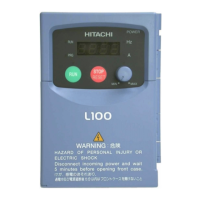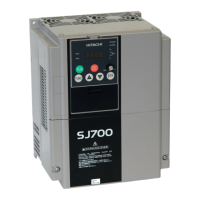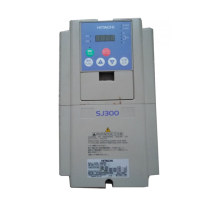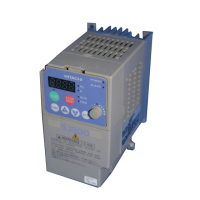Do you have a question about the Hitachi HFC-VWS3 U SERIES, HFC-VWS3 H SERIES and is the answer not in the manual?
| Category | Inverter |
|---|---|
| Model | HFC-VWS3 U SERIES, HFC-VWS3 H SERIES |
| Frequency | 50/60 Hz |
| Cooling Method | Forced air cooling |
| Protection Features | Overcurrent, Overvoltage, Undervoltage, Overheat, Short circuit, Ground fault |
| Dimensions | Varies by model (refer to datasheet) |
| Weight | Varies by model (refer to datasheet) |
Procedures for inspecting, unpacking, and storing the inverter unit.
Overview of the inverter's function, design, and operating principles.
Lists common issues that can damage the inverter or motor.
Emphasizes the need for qualified personnel for installation and servicing.
Recommends recording set-up data for future reference and maintenance.
Details the default configuration settings the inverter ships with.
Lists the technical specifications of the inverter including voltage, frequency, and protection features.
Details the various protection circuits like overcurrent, overvoltage, and overload.
Describes the signals the inverter can output, such as frequency arrival and running status.
Lists optional features available for the inverter.
Covers environmental conditions like ambient temperature and humidity.
Provides a table of inverter models with their output ratings, dimensions, and approximate weight.
Explains how to interpret the catalog number for inverter model details.
Guides users on how to select the correct inverter capacity for their motor applications.
Provides guidelines for selecting a suitable installation location and environment.
Covers important precautions and recommendations for power wiring connections.
Shows the layout and function of the main power terminals for different inverter classes.
Details how to select appropriate power wiring based on voltage drop and wire length.
Explains when and how to use an input transformer with the inverter.
Provides instructions and diagrams for proper grounding of the inverter.
Offers guidance on using shielded wire and maintaining cable separation for signal wiring.
Lists and describes the terminal designations for all input and output signals.
Explains how the inverter reacts to input phase loss and potential damage.
Details the various input signals and their terminal connections and electrical characteristics.
Explains the different output signals, their purpose, and electrical characteristics.
Shows the physical location and connection points of the PC boards within the inverter.
Provides a breakdown of the main, control, and protection circuits within the inverter.
Describes how the stall prevention feature protects against overcurrent during acceleration.
Explains the inverter's thermal protection mechanism for motors driven at varying speeds.
Lists and explains various fault and alarm messages displayed by the inverter.
Details how the inverter handles power interruptions and prevents unintended startups.
Illustrates typical wiring for controlling the inverter via the operator key pad.
Shows how to wire a thermal relay for motor protection.
Provides wiring methods to disable the unattended start protection feature.
Offers wiring diagrams for integrating a mechanical brake for motor stopping.
Describes wiring for optional function boards providing additional capabilities.
Explains the layout and function of the buttons on the operator key pad.
Details the information displayed on the inverter's 16-digit LCD screen.
Introduces the Monitor/Operator mode for viewing inverter status and parameters.
Lists and describes the 10 different displays available in Monitor/Operator mode.
Explains the function of the keys used for navigating and changing data.
Describes how to use the cursor movement key to navigate display fields.
Explains how to use increment/decrement keys to change displays and data values.
Details the function of the Forward, Reverse, and Stop keys for controlling the inverter.
Outlines the process for entering data and settings via the Monitor/Operator mode.
Explains how to use potentiometers and DIP switches for basic adjustments.
Details the function of each DIP switch on the logic board, including RAM flush.
Describes the use of M.ADJ and OL.LMT potentiometers for adjustments.
Guides users on how to program various set-up parameters using the operator key pad.
Provides detailed descriptions and settings for the inverter's programmable functions.
Outlines regular maintenance tasks to keep the inverter clean and functional.
Explains methods and circuits for measuring voltage and current outputs.
Details procedures for testing the inverter's power transistor modules.
Introduces the troubleshooting section and its diagnostic approach.
Provides a table of fault messages, their meanings, and suggested remedies.
Offers a flowchart to diagnose and resolve issues where the motor fails to operate.
Provides a flowchart for troubleshooting problems with motor acceleration.
Offers a flowchart to diagnose and correct situations where motor speed is excessively high.
Presents a flowchart for diagnosing and resolving overcurrent trip issues.
Provides a flowchart to address trips caused by momentary power interruptions.
Offers a flowchart for troubleshooting overheating alarms related to the heat sink fan.
Provides a flowchart for diagnosing and resolving undervoltage trip conditions.
Offers a flowchart for troubleshooting overload trip issues.
Provides a flowchart to diagnose and resolve overvoltage trip conditions.
Lists common initial start-up errors and their suggested remedies.











